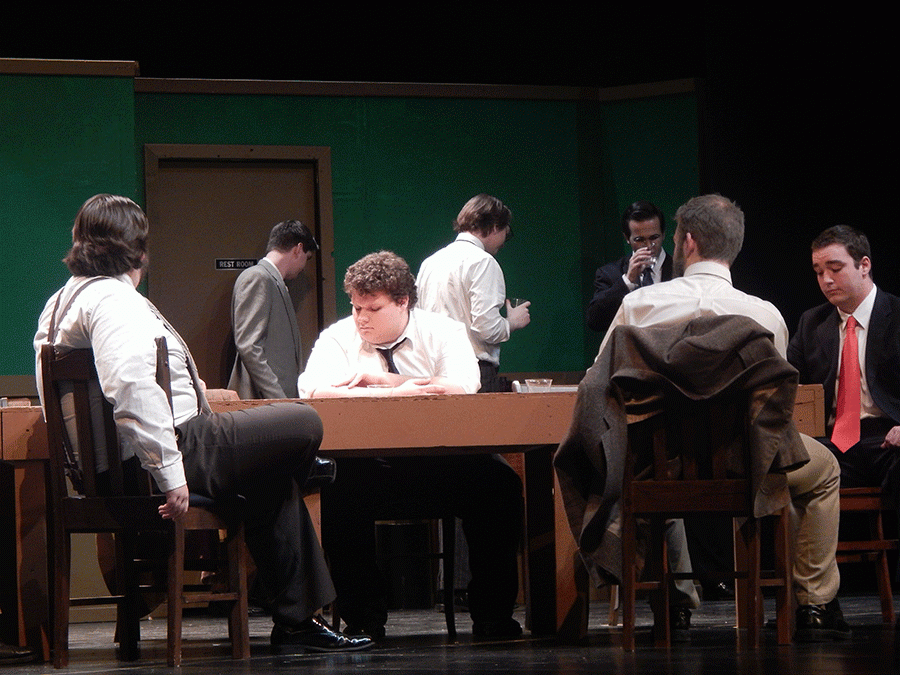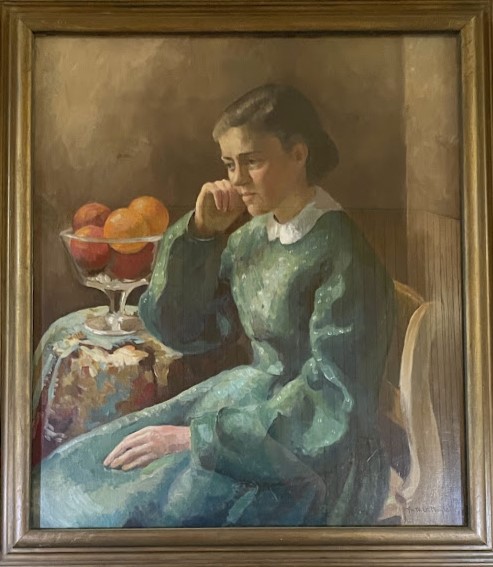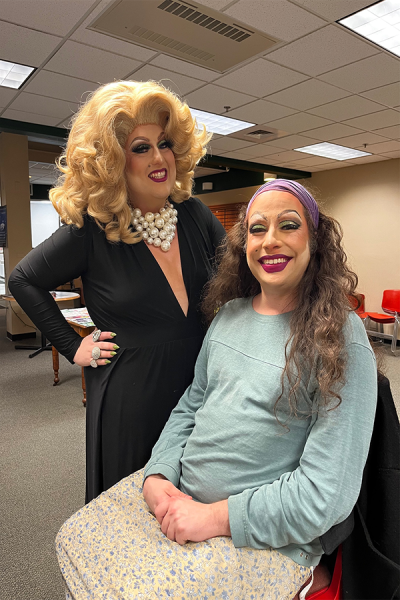Gunn’s “12 Angry Men” offers a provocative view of rough justice
Jury members Patrick Monaghan, Shawn Weibel, Neil Bresnahan, Jody Kifner, Sam Lewis, Tim Melville, and Josh Baughn deliberate
The Johnson community got a glimpse into the complicated and controversial world of courtroom drama when the classic “12 Angry Men” was performed on the Dibden stage.
“12 Angry Men” was written by Reginald Rose as a play broadcast on television in 1954. It was widely successful and was adapted into a film in 1957 which was directed by Sidney Lumet.
The story centers around a group of 12 jurors in a jury room. The defendant, a 19-year-old from a bad neighborhood, has been taken into custody for the fatal stabbing of his father. He faces the death penalty if found guilty.
The plot emphasizes the idea of “reasonable doubt” and explores the implications of sentencing a man to die if there is any trace of doubt that he committed the crime.
It was an almost-full house as students, faculty, parents and community members filed in to see the show on Nov. 13, which was directed by Thomas Gunn as his senior project. He proved his skills in organizing a cohesive, entertaining and extremely believable show. Rachael Garnjost was the stage manager.
The set, designed by Andrew Tascarella, who also portrayed the security guard, was the same throughout the show. A painted green and white wall bordered the jury room in which the plot develops, decorated with three windows, a clock and two doors. Placed on the stage were a coatrack, a refreshment stand, and a rectangular table with 12 chairs.
The windows were almost always illuminated with a deep, sky blue light. During the introduction, however, when a booming voice came over the loudspeaker to explain the situation to the audience, the windows were illuminated with crimson to underscore the severity of the situation. The stage was otherwise brightly lit, except during intermission and scene changes. The lighting was designed by Mackenzie Brown.
All of the jurors were appropriately dressed for the 1950’s, wearing formal suits, ties, and old-fashioned suspenders. I was quite shocked when Tim Melville came onstage as the ninth juror. He was clearly portraying an older man, because his hair and beard were dyed gray and his makeup made his face appear convincingly covered in wrinkles. The costumes and makeup were done by Samantha Gunn.
Sawyer Judkins portrayed the first juror and also acted as the foreman for the group. He played the part of the mediator well; his demeanor was stern but not overbearing, and he appeared to always be listening intently to what the other jurors were saying. His presence was especially pertinent to the audience when he sternly commanded, “Let the man speak.”
Josh Poland (juror three), Patrick Monaghan (juror 10) and Josh Baughn (juror eight) played three of the most outspoken characters of the group. They were very rigid with their moral positions, and they were often the ones attempting to persuade the other jurors.
Poland portrayed a convincingly infuriating, insufferable juror. He held fast to his position against the defendant until the last moments of the play, and often spoke to the other jurors in a harsh, mocking tone.
Jody Kifner, the second juror, couldn’t have said it better: “He [Baughn] has made a number of good points, while he [Poland] only gets mad and insults people.” During one particularly heated moment, Poland ran towards Baughn while shouting, “I’ll kill him!” This was highly ironic, considering they were just discussing how the accused yelling, “I’m going to kill you,” wasn’t definite evidence that he stabbed his father.
Kifner didn’t just deliver that one previously mentioned comedic line. From the very beginning he was anxious and fidgety. He sometimes threw out funny lines, such as “anyone want a cough drop?” to break the tension in a scene. Interestingly, this line was delivered both right before intermission and immediately after, which contributed to the continuity and reminded the audience where the play left off.
Monaghan was on the same side, although not for quite as long as Poland, so he did his fair share of shouting and arguing. When he yelled at other characters, he did so in harsh and jolting tones. When arguing that the defendant was not intelligent, he said, “He don’t even speak good English!” The audience chuckled.
Baughn, on the other hand, was passionately trying to get the other jurors to see that the lack of substantial or accurate facts left a trace of reasonable doubt of the man’s guilt. He was believable in this role and didn’t yell quite as often as the previous two jurors. When he did, it made the audience jump from the intensity. At one point, he shouted at the top of his lungs, “There is doubt, doubt, doubt,” and punctuated each “doubt” with his fist slamming on the table.
One of the most subtly believable characters was the fourth juror, played by Sam Lewis. He was always in character, whether he was trying to calm down other characters with a “now, now…” or idly cleaning his glasses. All of his lines were delivered with just enough of an upper-class diction. He was calm and reasonable, but Monaghan’s juror pushed him too far towards the end, and he walked up to him and coldly said, “If you open your mouth again, I’m going to split your skull.” This elicited a shocked “Ooh!” from the audience.
Colton White, who played the twelfth juror, sometimes spoke so quickly that I had a hard time hearing his lines. However, he made up for it by delivering each line with emotion, often exasperation or anger.
Neil Bresnahan, juror number six, didn’t speak very often but acted well when he did. When Poland pretended to stab Baughn with a knife during a reenactment, everyone jumped up and Bresnahan angrily yelled, “That’s not funny.” Although he sometimes messed up his lines, he recovered very well and made it seem natural.
Sawyer Masure portrayed juror eleven, who is originally from another country and speaks with an accent. Although it is never disclosed what country he is from, he makes references to his home and plays off the foreign aspect well. The accent he uses is not too ostentatious; it is just enough to convey his foreignness to the audience.
The other two jurors were Dakotah Senesac (juror number five) and Shawn Weibel (juror number seven). Senesac, in a similar way to Kifner, was very nervous and often easily persuaded in either direction. He communicated this through his stumbling sentences and constant vote changes.
As the security guard, Tascarella often had the responsibility of bringing in pieces of evidence for the jurors. When asked to bring in a poster board depicting the map of the apartment where the murder took place, Judkins thanked him, and Tascarella replied, “Sure, that’s my job.” The audience chuckled, understanding the clever reference to his job as set designer.
The sound for the production consisted of the voice over the loudspeaker at the beginning and music during intermission. The actors’ voices could be clearly heard and projected well. The sound was handled by Charles Munroe.
These 13 actors gave the audience insight into the moral dilemma that is the death penalty, showing their inner turmoil and indecision through their inflection, body language and often through outbursts of rage. Combined with the efforts of the crew, who provided the setting for the production, the audience was given a show that will likely leave an emotionally troubling imprint on their minds.








